Siosa line
T/n Irpinia 1955 & M/v Irpinia 1962 to 1983
Note: iPhones, iPads, Firefox & some other Search Engines may not be suitable
Use Google Chrome for this Web Page to load
perfectly!

Click
the logo above to reach the ssMaritime FrontPage for News Updates
With
Reuben
Goossens
Maritime
Historian, Cruise‘n’Ship Reviewer, Author & Lecturer
Please
Note: All ssmaritime and my other related
ssmaritime sites are 100% non-commercial and privately owned sites. Be assured
that I am NOT associated with any cruise or shipping companies or travel/cruise
agencies or any other organisations! The author has been in the passenger
shipping industry for over 60 years, but is now retired, but hopes that you
will enjoy the articles on many classic liners and cruise ships that have been
covered, all done for past passengers and classic ship enthusiasts to relive
those wonderful days gone by!

T/v
Irpinia
Ex: S.S. Campana
1929, S.S. Rio Jachal 1943, S.S. Campana 1946 to 1955
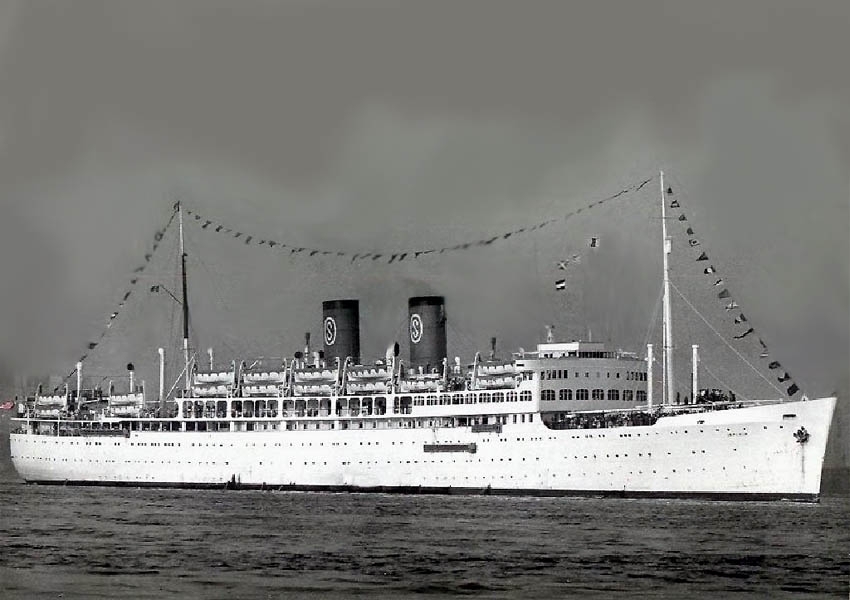
The
Turbine vessel - T/v Irpinia is seen in 1956 during a cruise
She
had been modernised, but in 1962 she received a massive transformation and
became a Motor vessel - M/v in 1962
Please
Note: If any Images are missing on this page, please
refresh the page!
Introduction:
This superb liner and cruise ship, the ‘Irpinia’ was,
as described in Part One, built as the SGTM liner S.S.
Campana in 1929 by Swan, Hunter
on the River Tyne. She sailed from Marseille to the East Coast of South
America, Rio de
Janeiro, Santos,
Montevideo,
and Buenos
Aires.
After the fall of France in 1940, the Campana was
laid up in Buenos Aires, but in July 1943 she was commissioned by the
Argentineans, for whom she ran some voyages to New York and back, having been
renamed ‘Rio Jachal.’
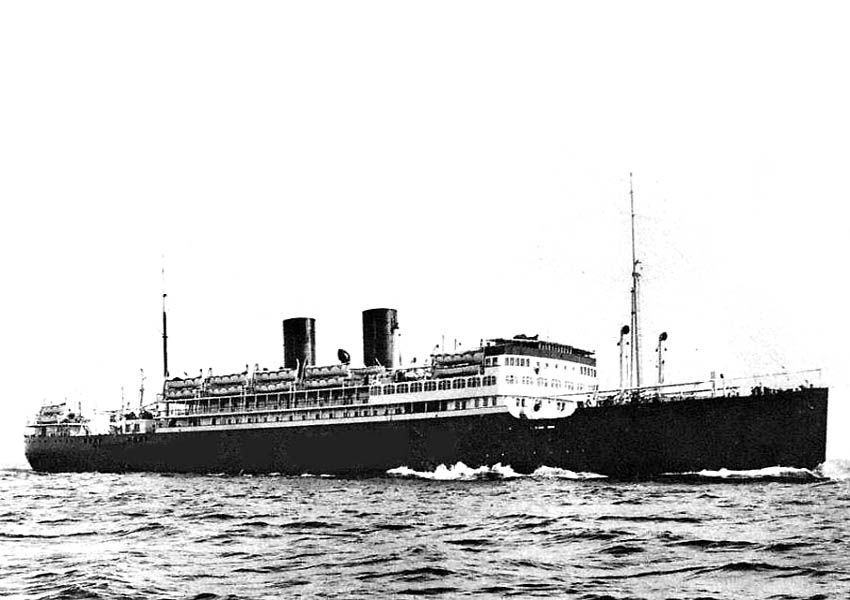
S.S. Campana
is seen after she was returned to SGTM in 1946
In 1946, she was returned to SGTM, and she recommenced on her regular
South Atlantic duties, until being chartered out, when she commenced voyages
via the Suez
to Indochina (Vietnam),
until late 1954 and she was placed on the market, but still in top condition!
From S.S.
Campana to TV
Irpinia:
In March 1955, the S.S.
Campana was obtained by
the Italian brothers Grimaldi who had created the Sicula
Oceanica,
Palermo
Italy,
and the ship was renamed ‘Irpinia.”
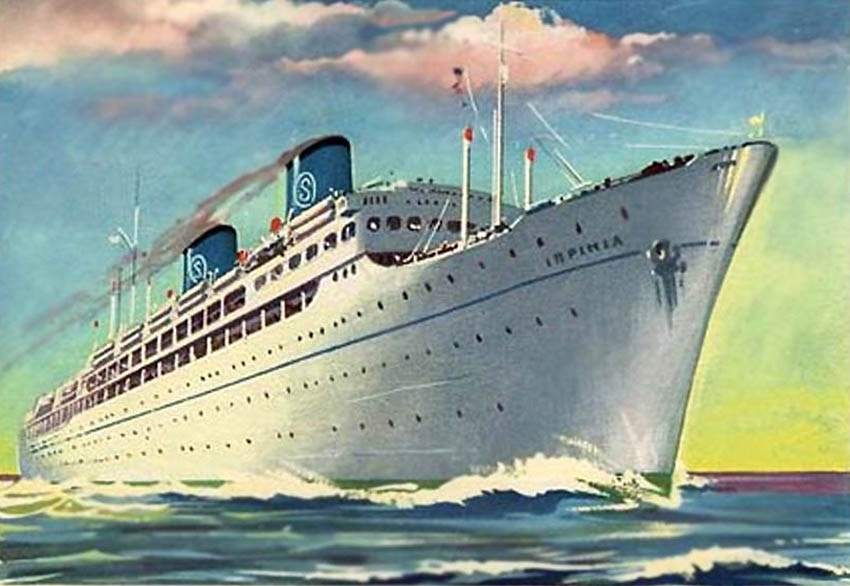
An
advance highly stylised illustration depicting the new T/v Irpinia
She was purchased to be operated on the
Trans-Atlantic service. She headed for Italy
where she was given an extensive refit and a partial rebuilding. This included
extending her aft decks as well as nicely raked bow, whilst her forward well
deck was enclosed. Internally her facilities were upgraded as she was to become
a two-class liner with 187 First Class passengers and 1,034 in Tourist Class A & B, in addition two swimming pools were installed as
well as all public venues being upgraded. Her six passenger Decks were
designated as follows; Boat, Lido,
Promenade, A, B and C Decks.
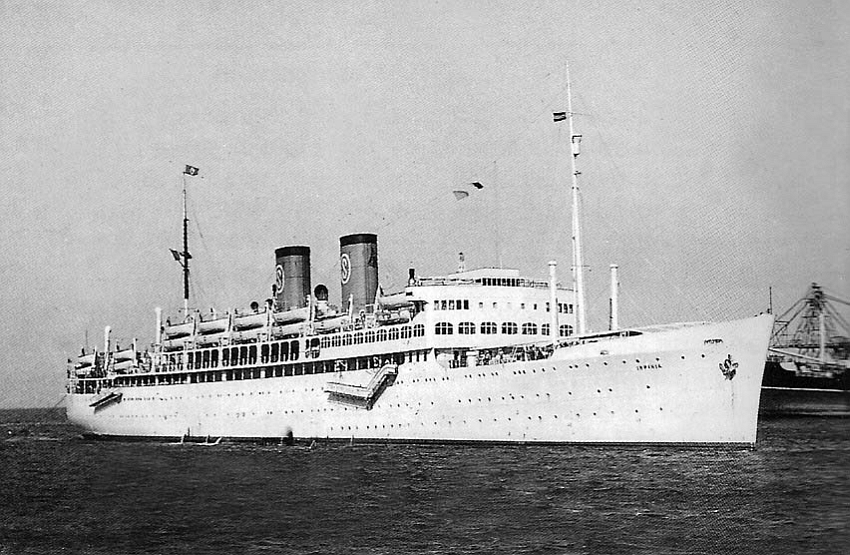
The
transformed T/v Irpinia
First Class:
Two Lounges were one forward and
one aft on Lido Deck as was their Swimming Pool together with a spacious Sun Deck.
These two venues were separated by cabins ranging from single rooms to twin and
three/four berth cabins, most of these having private facilities. The Dining
Room was located on Promenade Deck just forward of a Grand Lobby, or “the
Hall,” with cabins located amidships. Down on A Deck there were 18 cabins
located on the starboard side. The Children’s Room was located aft on
Boat deck.
Tourist Class A:
On Lido Deck aft there was the
Tourist Class Swimming Pool, and a vast open deck space. Whilst on Promenade
Deck two Lounges with a Bar were located aft of the First Class cabins, with a
Children’s Playroom a little further aft. Whilst outside, there was a
spacious fully covered promenade deck space, which was very popular on hot
sunny days. The large Dinning Room was located on A Deck aft with cabins aft,
and on B Deck, whilst on C Deck aft there were 5 dormitories.
Tourist B:
The Dinning Room and Lounges were
located forward on A Deck in the new enclosed well deck section. If taking the
stairs from below the main lobby down to B Deck, there was a section of two to
four berth cabins, whilst just forward of the Dinning Room, the stairwell there
would take you down to B Deck forward were six there were large dormitories.
Whilst C Deck had 16 dormitories of various sizes reached via the two
staircases mentioned earlier, as they were separate compartments.
TV Irpinia Completed & Ready to Sail:
Upon completion the T/v Irpinia
was registered in Palermo
(Naples),
Italy
and she was registered as being 12,279 GRT, having been given the IMO Number
5163675, and the Call Sign ICIR. She commenced services under the management of
the Grimaldi-Siosa Line.’
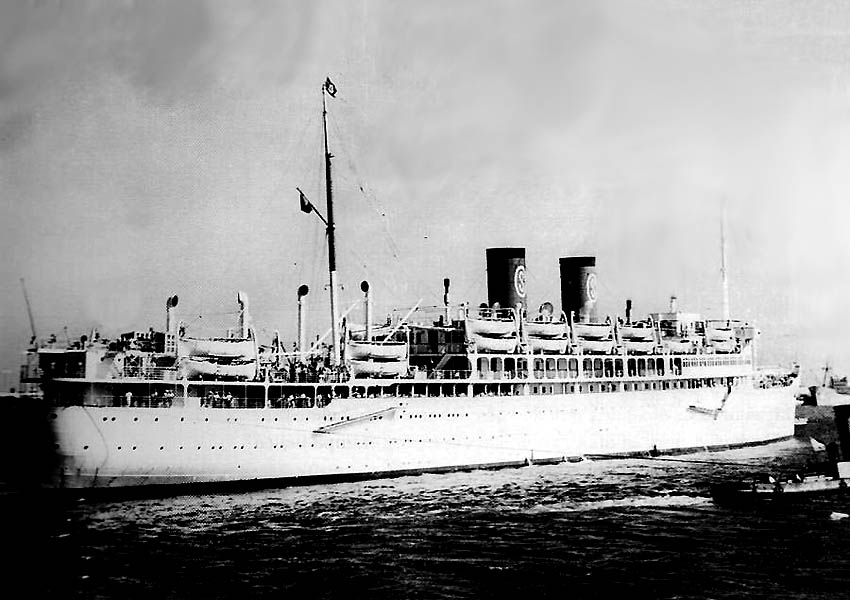
A
stern view of the Irpinia showing her extended aft decks and additional
lifeboats
Photo Album
First
Class
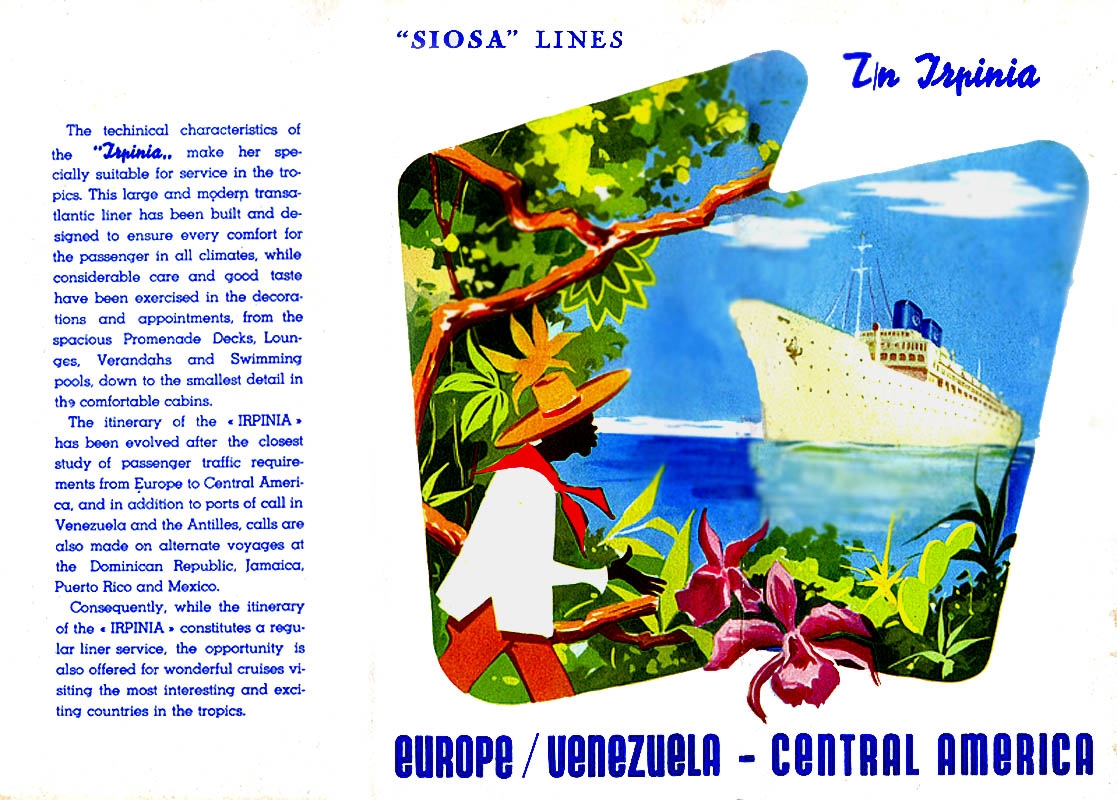
A
new brochure with an introduction to the new ship the T/n Irpinia
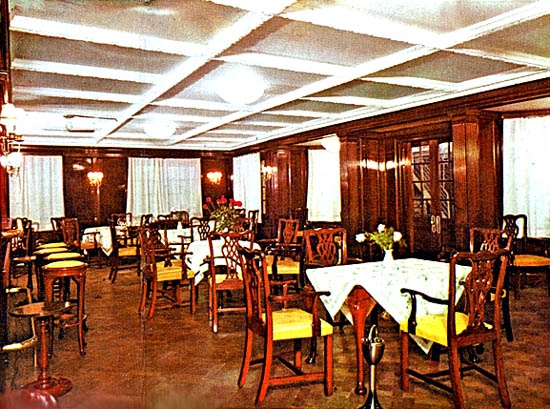
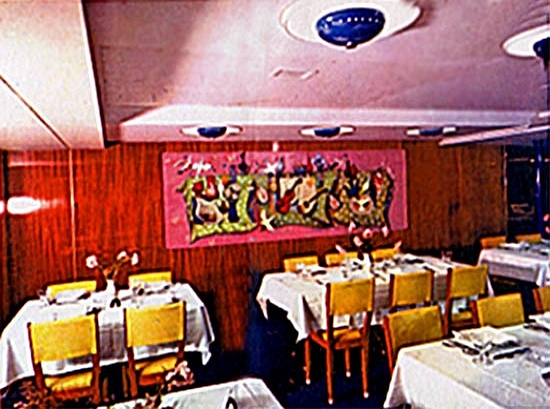
Left: The First Class Lounge on Lido
Deck & Right: The Dinning Room on Promenade Deck
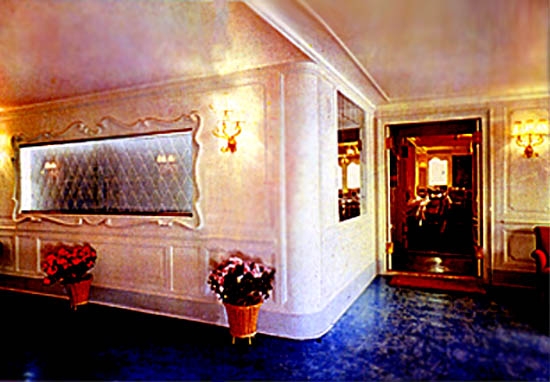
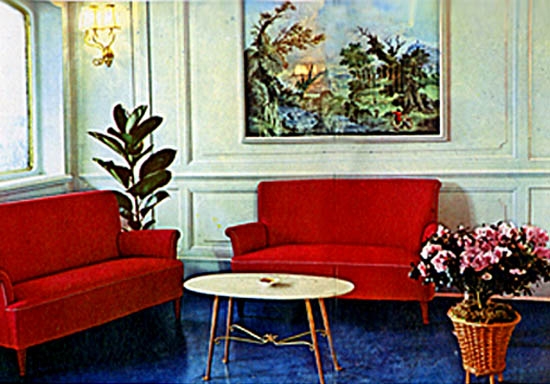
Left: The Grand Lobby (the Hall) looking into the Dinning Room on
Promenade Deck
Right: A cosy corner of “The Hall”
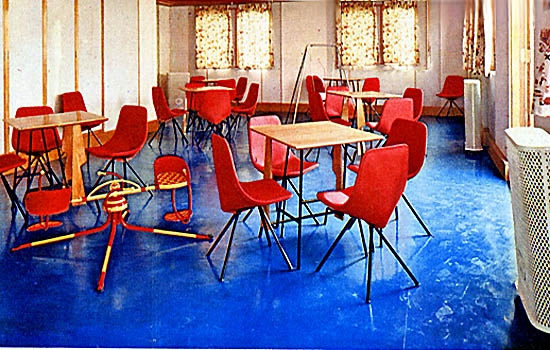
The
Children’s Playroom
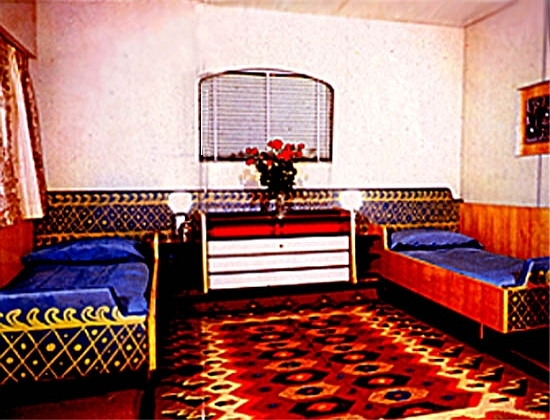
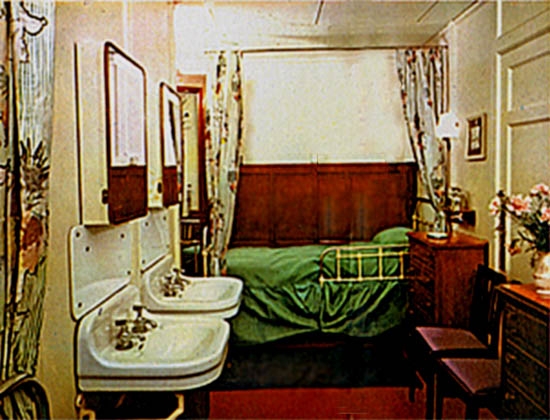
Left: A deluxe Suite Bedroom, there were only two Suites on Lido Deck
Right: An outside Twin bed Cabin on A Deck
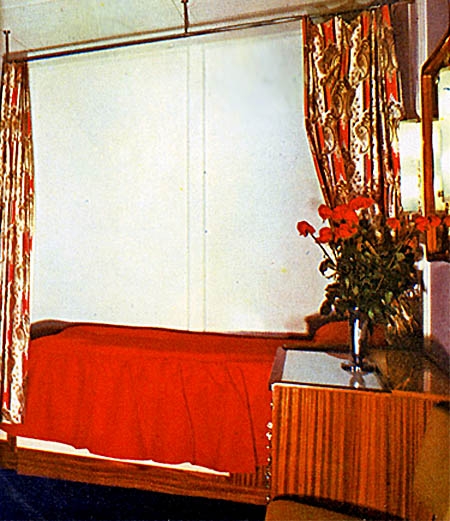
A
single bedded cabin on Promenade Deck
Tourist
Class
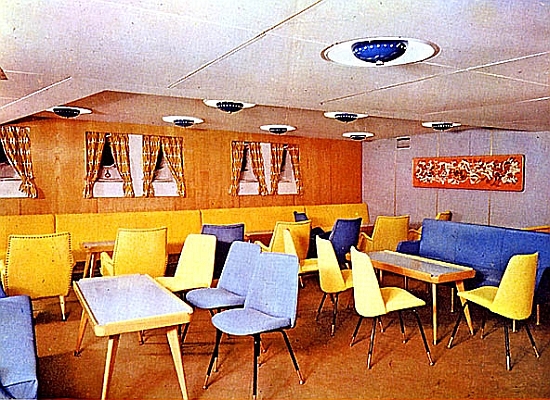
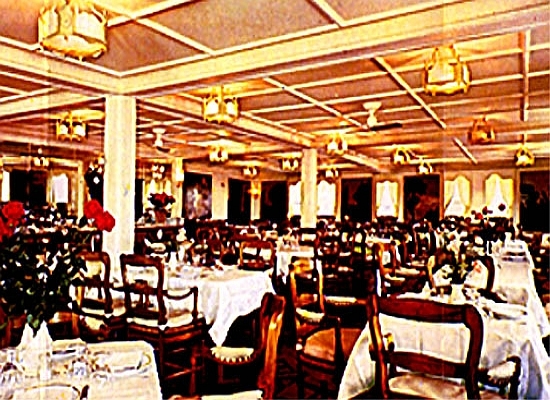
One
of the Lounges & the Main Dinning Room aft on A Deck
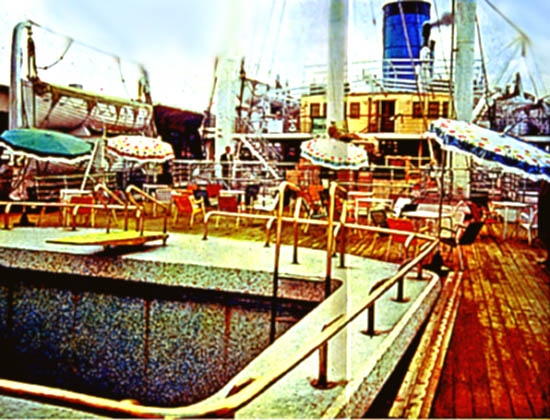
The
far aft Swimming Pool for Tourist Class, the First class is further forward
Please
Note: Deck Plans are available on Part Three
Use the
LINKS at the bottom of this page!
TV
Irpinia
1960 Schedules:
The Irpinia operated on a variety
of services between 1956 and 1962, as she first operated as a liner, in a first
and a Tourist Class A & B for the migrant service
from Italy
to South America.
The she was placed on the Naples, Genoa, Cannes, Barcelona Tenerife,
Guadeloupe, Martinique La Guaira and Trinidad
service, which was followed by the Palermo, Naples, Genoa, Halifax to New York
service, although on her return voyage she would omit Halifax.
Then she operated on the; Palermo, Naples,
Genoa, Quebec to Montreal service, yet during her return voyages she would call
at Cannes before arriving in Genoa. Just during one summer return voyage she
also called in at Gibraltar.
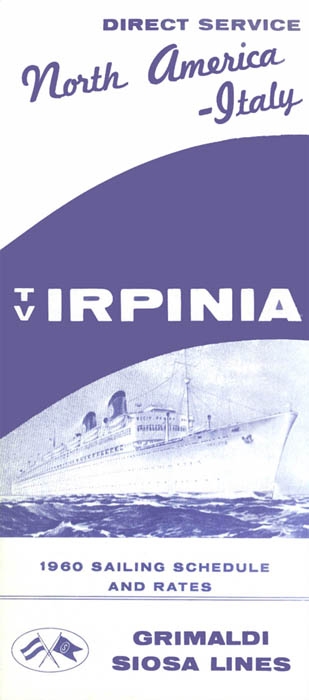
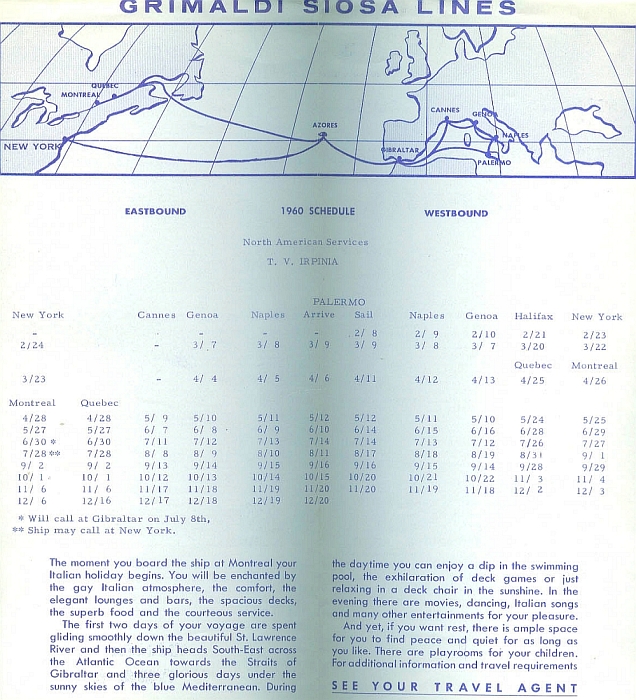
You
can click on the above schedules and a full size version will open
But in addition, Siosa Lines realised that the
Irpinia was also popular on shorter cruises around the Mediterranean.
Therefore during one of her regular dry-dockings for maintenance, she was given
some external and internal modernisation. She returned to operate a few more
cruises and proved to be very successful. However, the ship with her two tall
main masts and funnels looked like an aging ship, thus it was decided that she
required radical modernisation, which would take place for this fine ship!
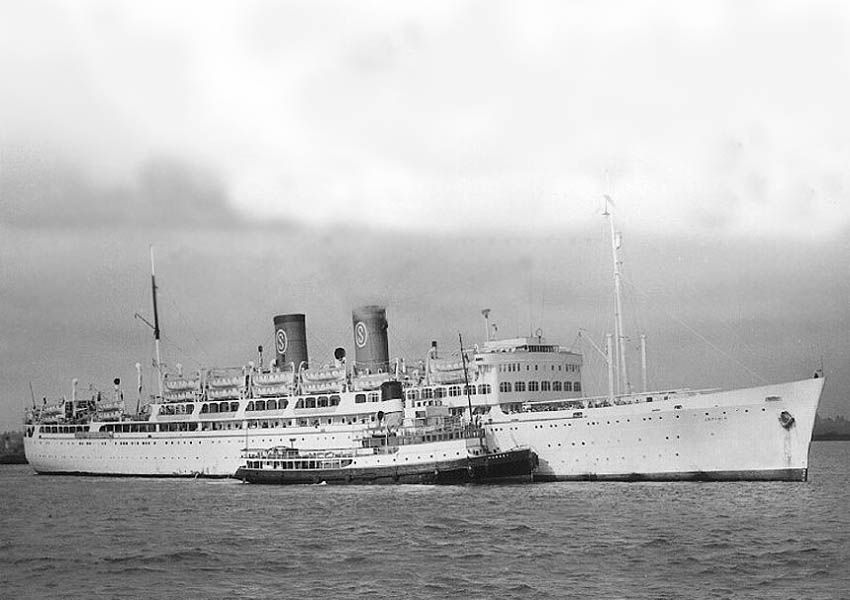
Her
we see a modernised T/v Irpinia in 1961, but soon she would be completely
rebuilt
M/v Irpinia 1962-1983:
In 1962 the ship was taken to the
Adriatico Shipyard at Trieste,
where she would receive a total metamorphosis into an almost brand new ship!
Her old steam turbines engines were removed and replaced by two modern FIAT
Diesel engines, which doubled her previous power, with 16 000 BHP, giving her a
new speed of 19 knots cruising speed, with a maximum of 20 knots. Externally
she was rebuilt with her two old funnels removed and a single shapely modern
style funnel installed. Her two tall mainmasts were removed and a shapely tall
signal, radar mast was placed atop her Bridge, whilst her forward kingposts
were modernised, and the aft section of Lido Deck was enclosed as a new full
width Lounge had been installed. Upon completion the amazing transformation of
this fine cruise ship had turned her into a modern ship, and it was very
difficult to see the original French liner in her, the 1929 built S.S.
Campana.
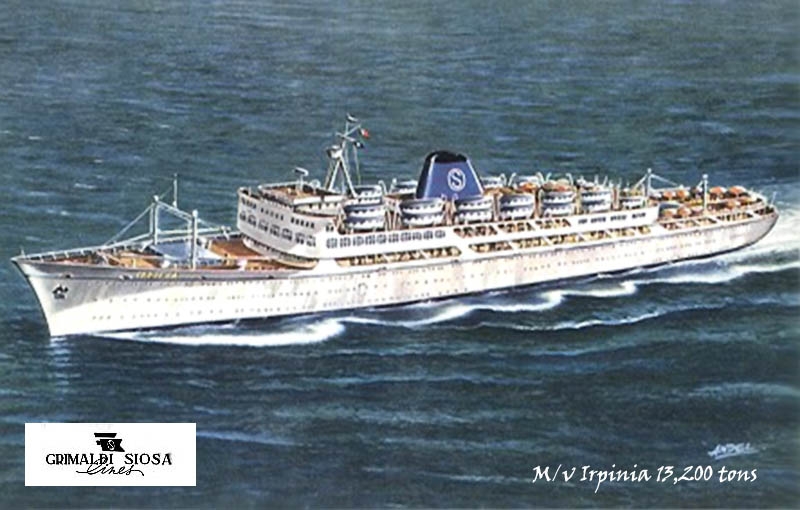
An
early postcard with an artist impression of the all-new M/v Irpinia
Internally all her public venues received a massive
overhaul, with a total of fourteen modern and spacious public venues installed,
which included a winter garden, three restaurants, four bars, as well as a
night club. First Class now accommodated 209 passengers, in 74 cabins, made up
as single bed, twin bedded, and three berth cabins. Tourist Class now
accommodated 972 passengers in 256 cabins, made up of two, four, and six berth
cabins. The two classes had 166 cabins with private facilities (PF); with most
cabins in First Class having PF!
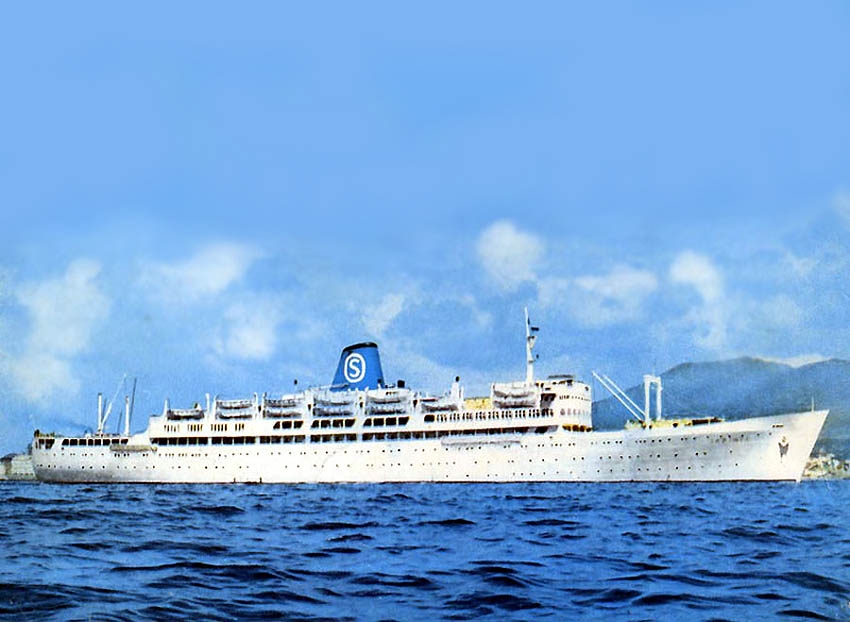
Here
we see the completed all new motor vessel M/v Irpinia
Photo Album
First
Class
Please Note: As we view this Photo Album, I will commence topside and slowly
head down the ship and commence forward of the ship and slowly move aft.
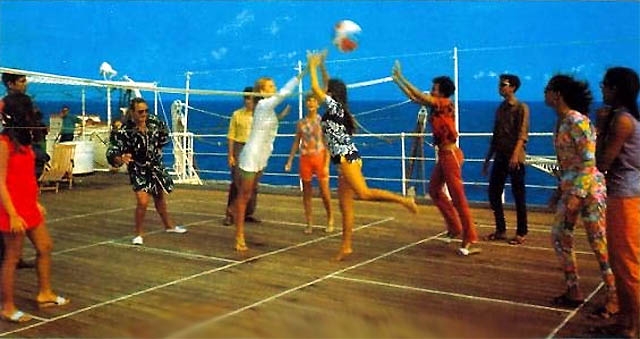
There
was ample space for a variety of sports topside on Sun Deck
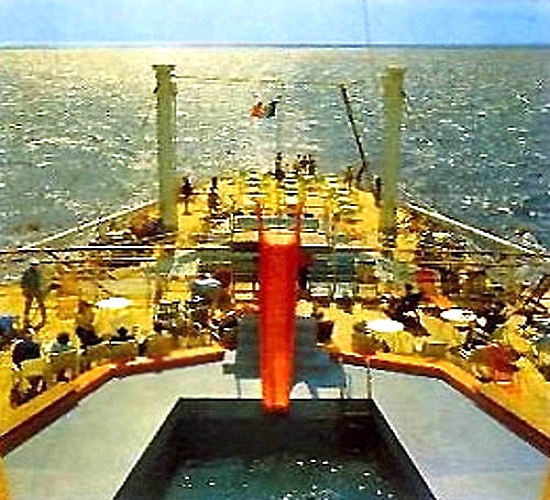
Here
we see the First Class Swimming Pool located aft on Boat Deck
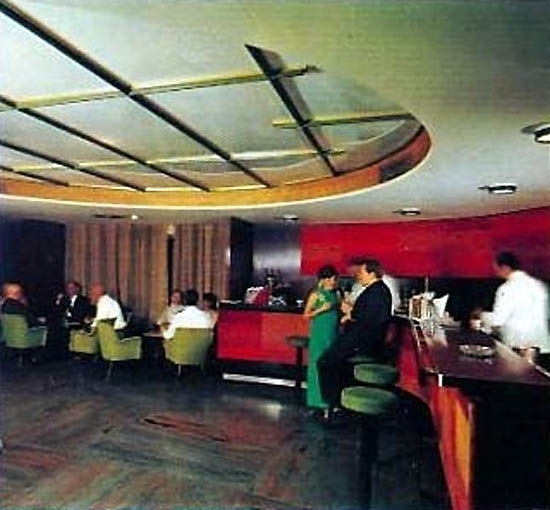
The
delightfully intimate Venezia Lounge and Bar far
forward on Lido Deck
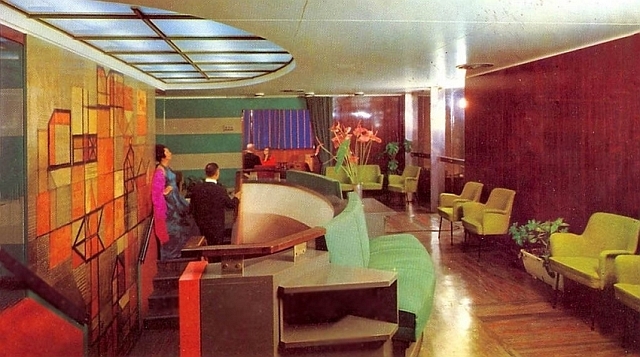
Lido
Deck: First Class Forward Foyer and Stairwell

On
Lido Deck there are two of these spacious deluxe twin staterooms with an extra
large Bathroom
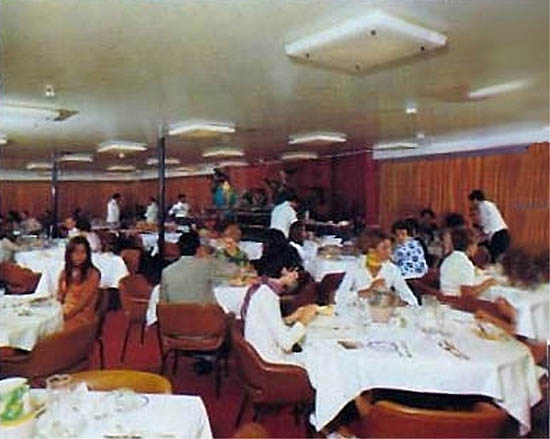
The
Belvedere Restaurant is located on Promenade Deck forward
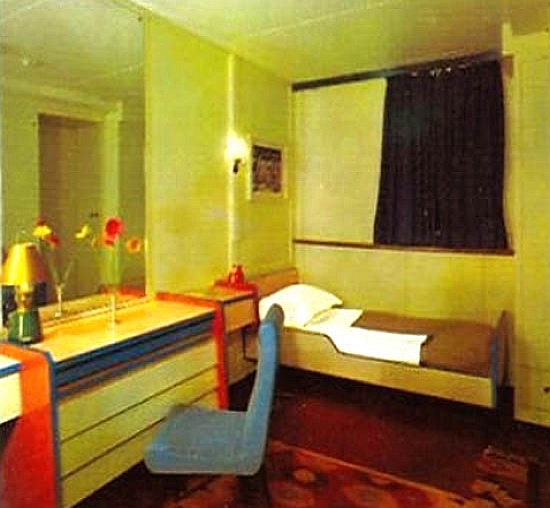
Here
we see a Twin bedded cabin on Promenade Deck
Tourist
Class
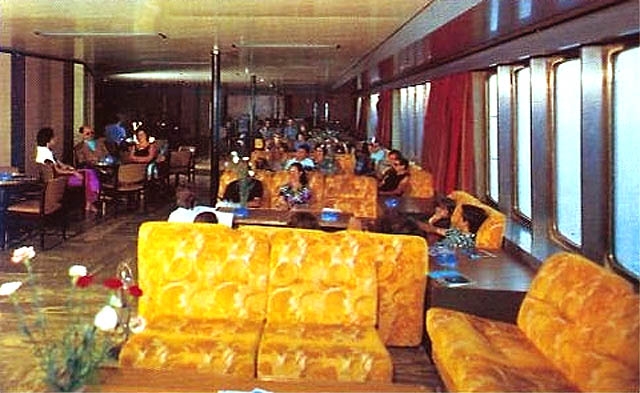
Aft
of the First Class accommodations on Lido Deck was the spacious Dalmazia Lounge
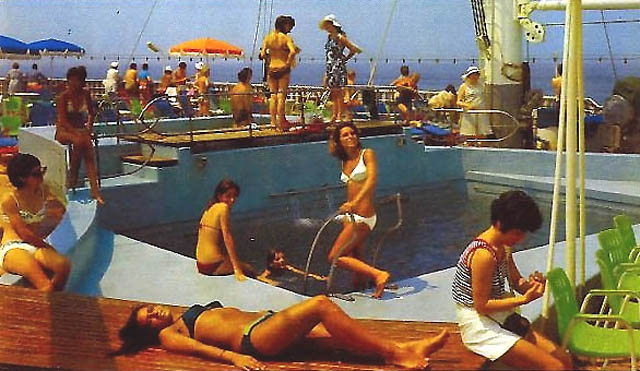
Aft
of the Dalmazia Lounge was the Buffet and the
Swimming and a children’s Pool
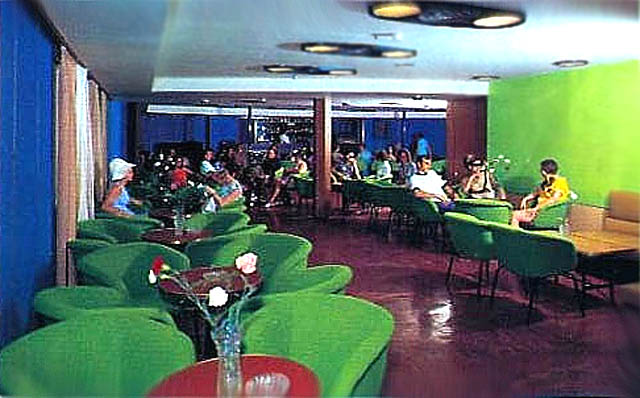
Here
we see the delightful Sicilia Ballroom on Promenade Deck aft
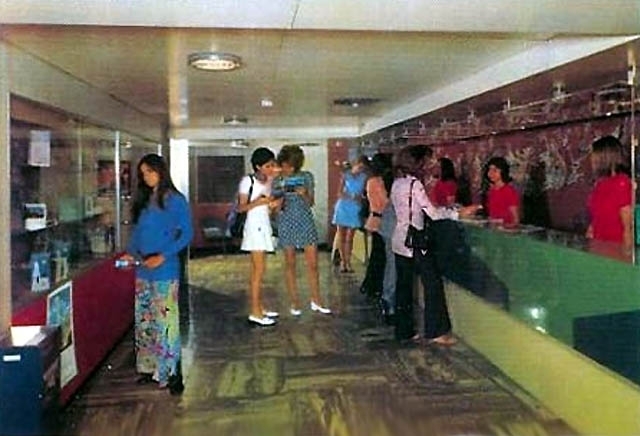
Directly
aft of the Ballroom was the Cruise Office and a shop as well as a spacious
covered deck
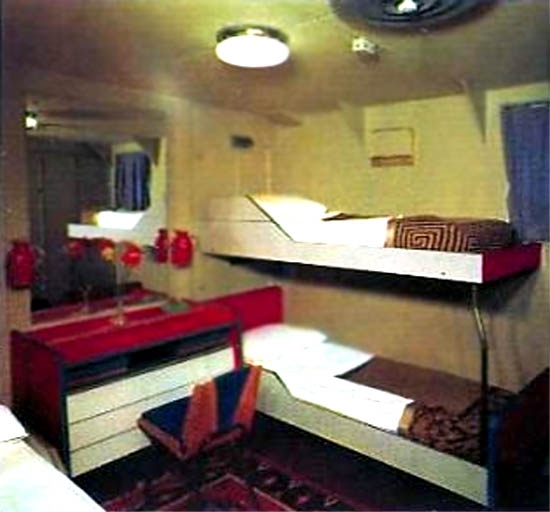
This
is a typical 4-berth cabin on Main Deck aft
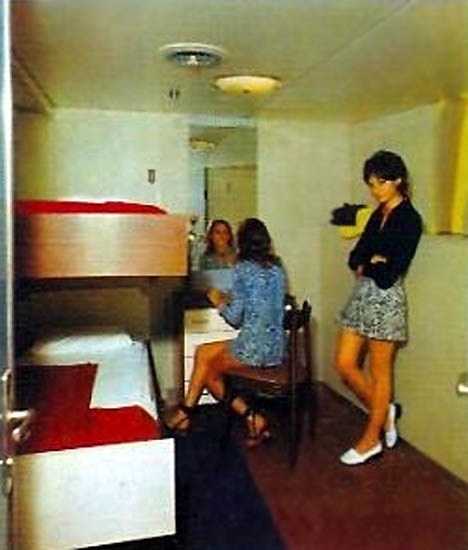
And
an inexpensive 2 berth cabin on A Deck aft
For Interest: The Tourist Class Riviera Restaurant, with two smaller dinning
rooms located on port and starboard sides was located on Main Deck aft.
Please
Note: Deck Plans are available on Part Three
Use the
LINKS at the bottom of this page!
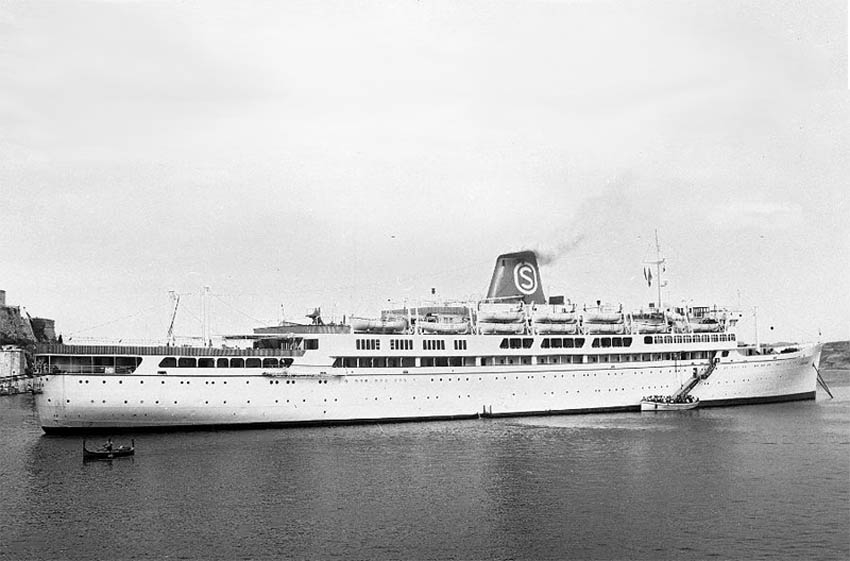
M/v
Irpinia is seen at anchor in port with one of her tenders attending to the
ships passengers
1962/63 Schedules:
Upon completion this beautiful
modern ship, yet already 34 years of age, recommenced duties to the Caribbean,
taking Spanish and Portuguese migrants Westbound, and collecting West Indian
migrants Eastbound mostly bound for the UK.
Her schedules commenced as follows; Naples, Genoa, Cannes, Barcelona, Tenerife,
Martinique, Trinidad, Barbados, La Guaira,
Guadeloupe, Tenerife, Barcelona, Cannes, Genoa, Naples.
Additional ports of call on some voyages would
be: Las Palmas,
Guadeloupe & Barbados westbound & Trinidad,
Grenada,
Martinique,
Dominica
& Antigua
eastbound. Whilst one return voyage in
December/January she operated her eastbound voyage as follows: La Guaira, Curacao, Kingston,
Tenerife, Madeira, Lisbon,
Vigo,
Le Havre
to Southampton
and v.v.
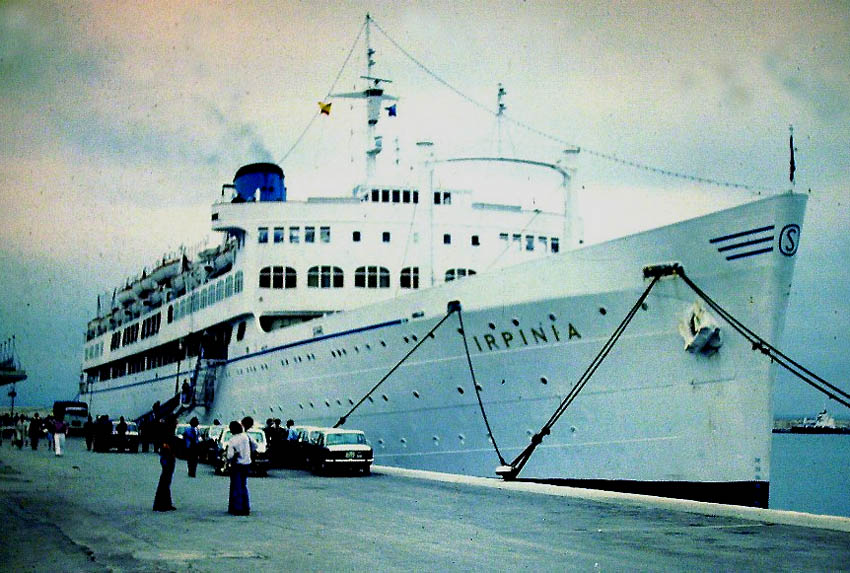
The
Irpinia is seen here berthed at Le
Havre, France
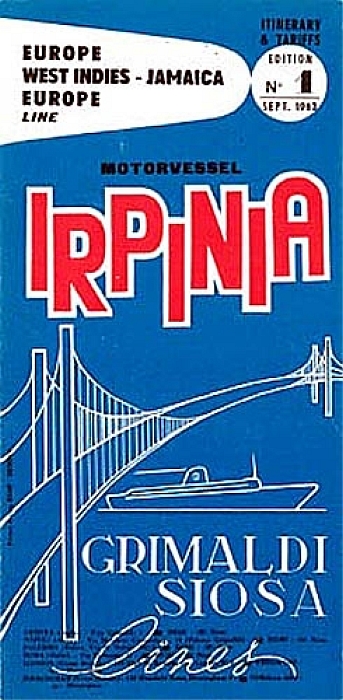
1963 M/v
Irpinia Fares and schedule to the West
Indies,
In addition to M/v Irpinia’s
line voyages to the Caribbean, the United
States, as well
as to Canada,
she also operated seasonal holiday cruises from one to two weeks, which proved
to be very popular.
However with the ships cruise successes, by
1970 the Irpinia was mostly used on cruise duties, being based in Genoa and
operating short Mediterranean cruises, as well as a cruise to The USA and the
Caribbean; which at the time were at a cost from US$79 for seven days, or
US$134 for a fourteen-day Christmas cruise to New York and the Canaries.
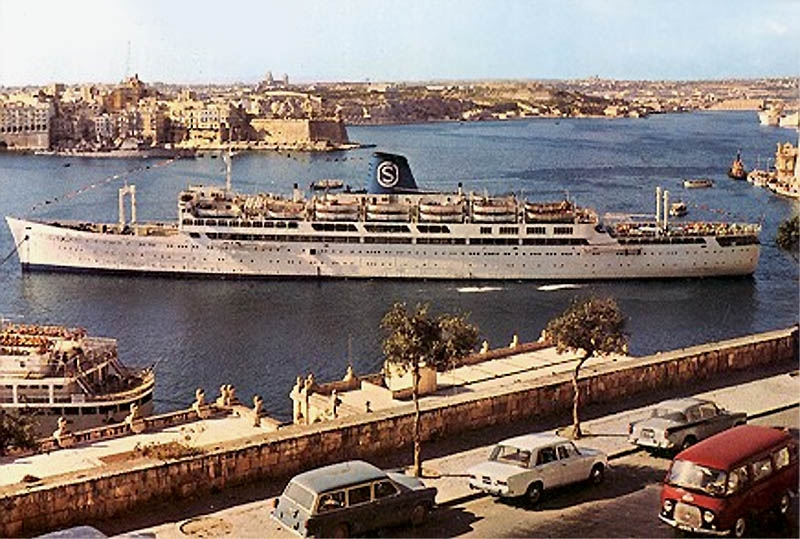
A
postcard of the Irpinia seen in Malta
She continued with her various cruise duties
and she gained a huge following, as she proved a comfortable ship, being a
superbly British built ex French liner, as well with her extensive
modernisations, she was a most attractive as well as an intimate ship and
proved to be one of the friendliest and happiest ship afloat!
Withdrawal & A Movie:
In 1976 the company decided to
withdraw the Irpinia from service, considering she was already an amazing 47-years of age and were planning to sell her to the
breakers. However before she could be sold, something astounding occurred; for
‘Grimaldi Sicula Oceanica’ was contacted by “Associated
General Films” who intended to make a ‘Lew Grade’ movie
entitled the ‘Voyage of the Damned,” and they required a suitable
older style liner and the 1929 built M/v
Irpinia was perfect. Thus they chartered her for the making of this major movie
event, which had a massive cast of some of the finest and best-known actors of
that time!
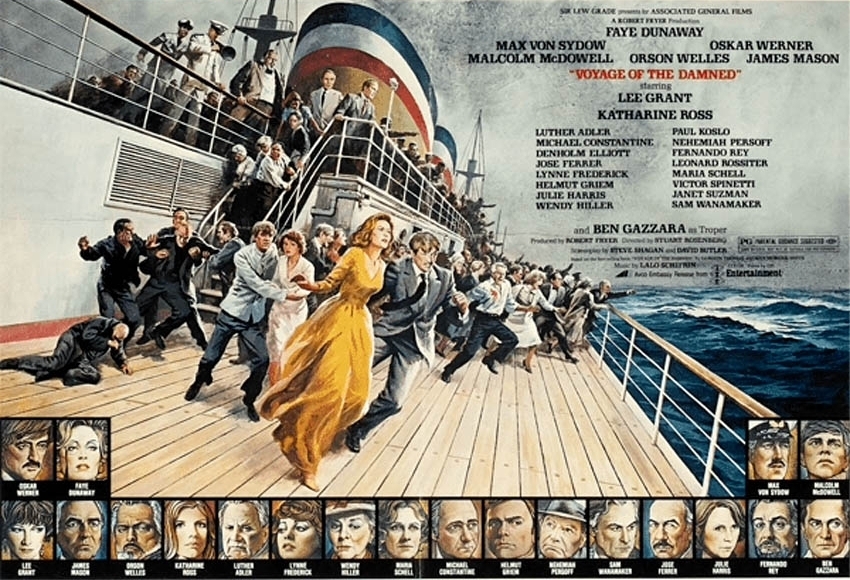
One of
the many movie posters
The story of the movie was based on the actual
events that took place in 1939, when the German luxury liner, M.S. St. Louis
carried Jewish refugees from Germany
to Cuba.

This
is the actual Hamburg America Line 16,730-ton M.S. St Louis was
completed in 1929
The M.S. St Louis departed from Hamburg
with 937 Jewish men women and children all of whom were seemingly had been
issued visas to enter into Havana,
Cuba.
The passengers, having seen and suffered massive anti-Semitism in Germany,
realised this might be their only chance of escape. Thus the film details the
emotional journey of the passengers who gradually become aware that their
passage was really a Nazi propaganda exercise, for it was never intended that
they would ever disembark in Cuba,
as for the Nazis had in reality given them visas that were forgeries. The truth
was that they were to be set up as Pariahs, to set an example before the world.
Just like a Nazi official in the movie states; “When the whole world has
refused to accept them as refugees, no country can blame Germany
for the fate of the Jews.” However, Captain Gustav
Schröder
who was a good and honest man, did not know any of
this until the M.S. St Louis arrived in Cuba,
and he tried everything to get them into Havana.
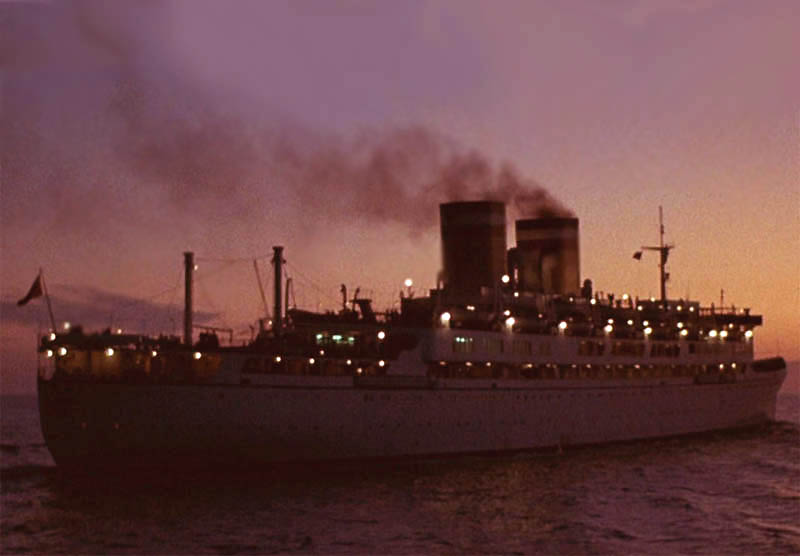
The M/v
Irpinia is seen here in the movie looking like the M.S. St Louis with the two
funnels
Shortly before the film’s end, it is
revealed although the Captain did everything to find safe havens for his
passengers but the governments of the United States, Britain and other
governments flatly refused to take a single one of these poor refugees, as the
ship reached Europe again it was only the Netherlands, Belgium, France. Then
the finally United Kingdom agreed to accept some of the passengers as refugees.
As they cheered and clapped at the news, tragically the footnotes in the film
clearly disclose the fates of so many of the passengers on board, suggesting
that over 600 of the 937 Jewish passengers did not survive, for those who
disembarked in Europe all the mentioned countries were invaded by Nazi Germany
and in due course they lost their lives in Auschwitz concentration camp, as
well in other death camps. It was only a small number of the St
Louis passengers who were fortunate to be taken in by the UK
that survived. If you ever get a chance get a DVD of the “Voyage of the
Damned” and watch this epic Movie Event, it is worth while for more that,
one reason! The story of course, but also the many views of the ship!
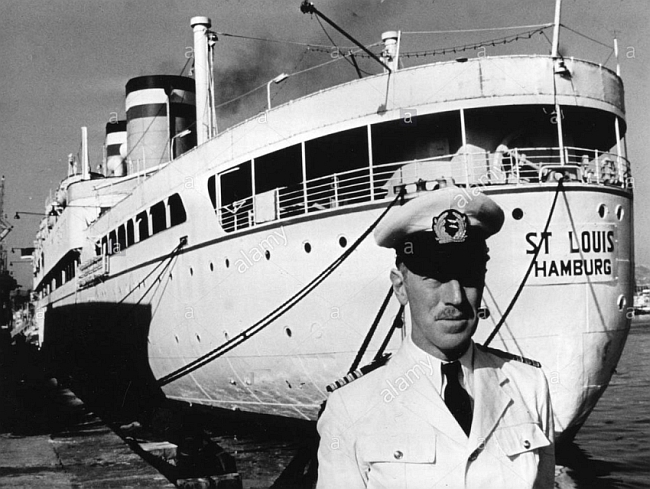
Here we
see the Irpinia transformed as the M.S. St Louis, with famous
actor Max von
Sydow as Captain
Gustav
Schröder
A dummy
funnel was placed over her actual funnel and another located just aft, but they
retained her white hull
‘Voyage of the Damned’ won Golden
Globe Awards for being the Best Motion Picture and Supporting Actress. It was
without a doubt an amazing movie, but sadly it was a grossly under-rated film
by the public, but later it had a huge revival!
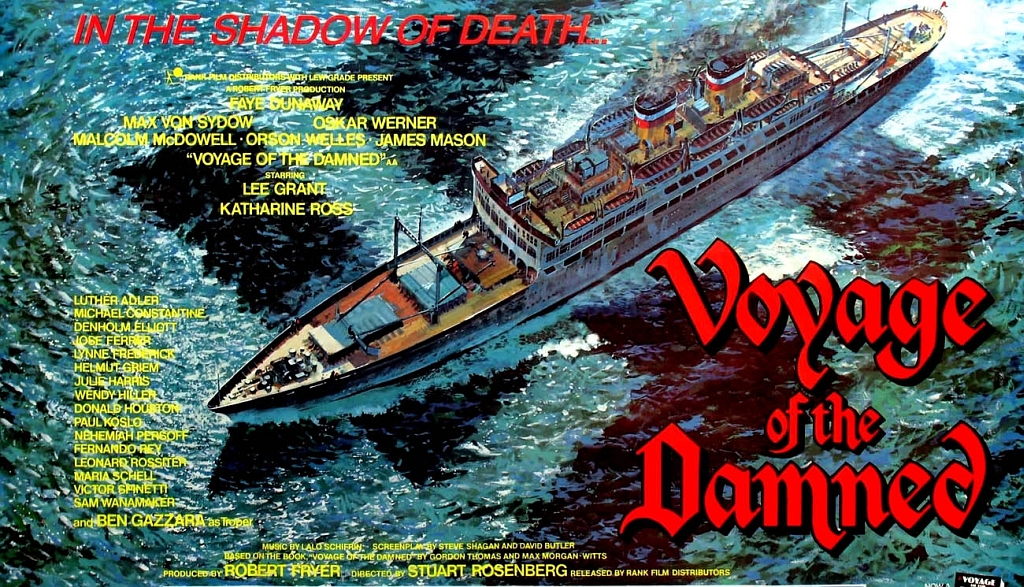
Another
poster for the movie, a link is located at the bottom of the page for you to
watch the full Movie!
M/v Irpinia and her concluding Days:
After the filming concluded T/v
Irpinia was returned to Grimaldi Siosa Lines, and remarkably she was placed
back into her previous Mediterranean cruise duties out of Genoa, and operated
these very successfully for the next two years. There was no doubt that the
public loved this wonderful ship!

M/v
Irpinia is seen berthed at her home port
of Genoa
Ready to depart for
another cruise
Photograph
by & © Enrico Righett
However in 1981, when she was due for her next
major certification inspection by “Registro Italiano
Navale,”
sadly the Irpinia was unable to obtain a new certificate of seaworthiness in Italy.
This was mostly due to her considerable age and the cost of upgrading her would
be huge, therefore Grimaldi Siosa Lines decided with great sorrow to having to
sell this grand old girl. She was obtained by Cant Nav
Santa Maria S.p.A., ship breakers in La
Spezia, Italy.
Soon she headed to La
Spezia,
and having arrived she was laid up until she would be broken up. For some
reason she remained in lay-up for 2 long years, but then in September 1983
breaking up commenced of this ship still in perfect condition, being 54 years
of age having been named the; ex S.S. Campana, S.S. Rio Jachal,
S.S. Campana. T/v Irpinia & M/v Irpinia.
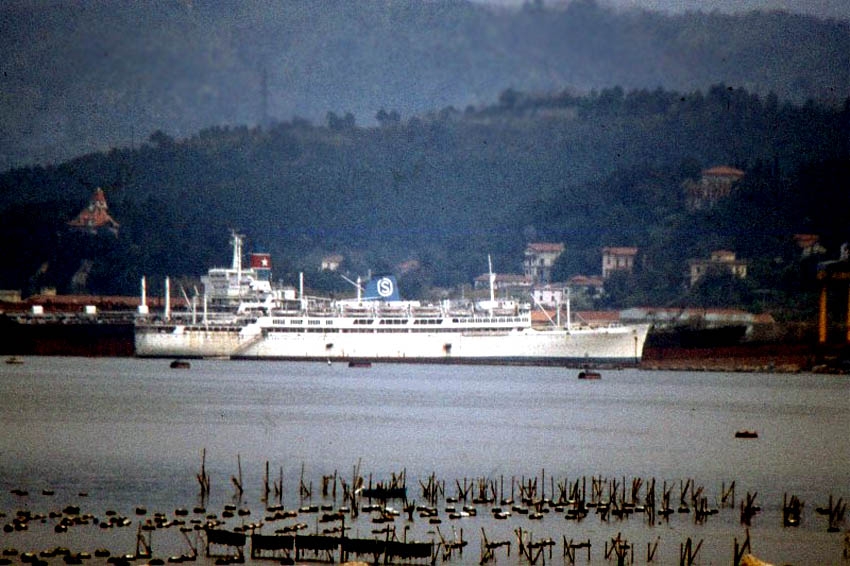
T/v
Irpinia is seen laid up at La
Spezia
awaiting her end
Photograph
by & © Alan Blakely
Details T/v Irpinia 1955 - M/v
Irpinia 1962 to 1983:
Owner: Sicula Oceanica, Palermo Italy.
Manager: Siosa
Lines - later Grimaldi Siosa Lines.
Registered: Palermo,
Italy.
Call
Sign: ICIR.
IMO
Number: 5163675.
Tonnage: 12,279
GRT in 1955.
. 13,204 GRT in 1962.
Length: 537ft
- 163,67m - 1955.
Width: 67ft
- 20,42m.
Draught: 23.10ft - 7,28m.
Engines: 6 x
Steam SR Geared Turbines – as built in 1929.
. FIAT Diesels 1,600 BHP in 1962.
Propellers: Two.
Speed: 17 knots
service speed, 17.5 knots maximum 1955.
. 19
knots cruising speed, 20 knots maximum 1962.
Passengers: 187 First Class & 1,034 Tourist Class - 1955.
. 201
First Class & 972 Tourist Class - 1962.
Remembering
the Wonderful and Much-Loved
M/v Irpinia
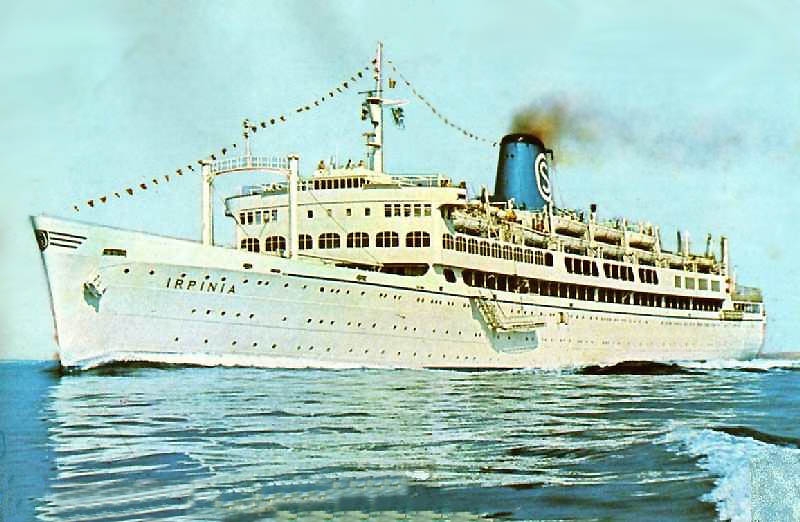
Campana/Irpinia INDEX:
Part One - S.S. Campana: …………………………The
history of S.S. Campana,
S.S. Rio Jachal & S.S. Campana - 1929 -1955.
Part Two - T/V & M/V Irpinia: ………………The
refurbished & rebuilt T/v-M/v Irpinia - 1955-1983.
Part Three: ………………………………………………..Irpinia
Brochures, Deck Plans and memorabilia.
You can
watch the movie in full HERE
or use the link below
https://archive.org/details/Voyage.Of.The.Damned.1976#
View … https://youtu.be/nVONWDGzhAU a 3.16-minute
interior film of the M.S. St Louis
************************
“Blue Water Liners
sailing to the distant shores.
I watched them come, I watched them go and I watched them die.”
************************
ENTER OUR ssMaritime MAIN INDEX
Where you will discover over 1,355 Classic
Passenger & Passenger-Cargo Liners!
ssMaritime.com & ssMaritime.net
Where
the ships of the past make history & the 1914 built M.V. Doulos Story
The Author has been in Passenger Shipping
& the Cruise Industry for over 60 years!
Photographs
on ssmaritime and associate pages are by
the author or from the author’s private collection. In addition there are
some images that have been provided by Shipping Companies and private
photographers or collectors. Credit is given to all contributors. However,
there are some photographs provided to me without details regarding the
photographer/owner concerned. I hereby invite if owners of these images would
be so kind to make them-selves known to me (my email address may be found on www.ssmaritime.com only), in order that due credit may be given.
This notice covers all pages, although, and I have done my best to ensure that all photographs
are duly credited and that this notice is displaced on each page, that is, when
a page is updated!
ssMaritime is owned & © Copyright
by Reuben
Goossens
- All Rights Reserved
















































